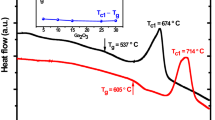Abstract
Metal nanoparticles (NPs) are precipitated on the surface or within the glass; such glass has attracted considerable interest because of its potential practical applications in optics, electromagnetics, and biosensing devices. Although such glass has been prepared via the deposition of separately synthesized NPs or via secondary heating of glass doped with metal ions, developing a well-designed NP-doped glass still remains a formidable challenge. Here, we succeeded in precipitating Ni NPs on the surface and within the glass by heating the Ni2+-doped Al2O3–SiO2 glass under hydrogen gas. The Al2O3–SiO2 glass prepared via melt quenching comprised two phases in which the Ni2+ ions were preferentially bound in the Al3+-rich phase. When hydrogen gas was loaded, it diffused in the glass; then, Ni2+ ions were reduced to Ni atoms, concurrently forming Al–OH bonds. The reduction of Ni2+ ions was discussed in relation to the hydrogen diffusion and reaction with the Ni2+ ions. The optical absorption band at ~ 350 nm wavelength could be assigned to the surface plasmon resonance of Ni nanoparticles. The precipitated Ni NPs moved toward the glass surface, which were removed using an acid solution. Thus, Ni-free glass exhibited fast H2 and He gas diffusion rates compared to silica glass.









Similar content being viewed by others
References
Kenyon AJ (2002) Recent developments in rare-earth doped materials for optoelectronics. Prog Quantum Electron 26:225–284
Maier SA (2007) Plasmonics: fundamentals and applications, 1st edn. Springer, New York
Duffy JA, Ingram MD (1976) An interpretation of glass chemistry in terms of the optical basicity concept. J Non-Cryst Solids 21:373–410
Duffy JA (1996) Redox equilibria in glass. J Non-Cryst Solids 196:45–50
Lin Z, Zeng H, Yang Y, Liang X, Chen G, Sun L (2010) The effect of fluorine anions on the luminescent properties of Eu-doped oxyfluoride and aluminosilicate glasses. J Am Ceram Soc 93:3095–3098
Cao T, Chen G, Lu W, Zhou H, Li J, Zhu Z, You Z, Wang Y, Tu C (2009) Intense red and cyan luminescence in europium doped silicate glasses. J Non-Cryst Solids 355:2361–2364
Nogami M, Le HX, Vu QX (2019) Novel silicate glasses in the acceleration of hydrogen diffusion for reducing dopant metal ions. J Non-Cryst Solids 503–504:260–267
Nogami M, Nguyen TTA, Vu QX, Kato K, Matsuoka Y (2018) One-step fabrication of Cu nanoparticles on silicate glass substrates for surface plasmonic sensors. J Non-Cryst Solids 495:95–101
Mao H, Selleby M, Sundman B (2005) Phase equilibria and thermodynamics in the Al2O3–SiO2 system: modeling of mullite and liquid. J Am Ceram Soc 88:2544–2551
Macdowell JF, Beall GH (1969) Immiscibility and crystallization in A12O3–SiO2 glasses. J Am Ceram Soc 52:17–25
Sen S, Youngman RE (2004) High-resolution multinuclear NMR structural study of binary aluminosilicate and other related glasses. J Phys Chem B 108:7557–7564
Lacy ED (1963) Aluminum in glasses and in melts. Phys Chem Glasses 4:234–238
Schmucker M, Schneider H (2002) New evidence for tetrahedral triclusters in aluminosilicate glasses. J Non-Cryst Solids 311:211–215
Risbud S, Kirkpatrick RG, Taglialavore A, Montez B (1987) Solid-state NMR evidence of 4-, 5-, and 6-fold aluminum sites in roller-quenched SiO2–A12O3 glasses. J Am Ceram Soc 70:C10–C12
Sato RK, McMillan PF, Dennison P, Dupree R (1991) High-resolution 27Al and 29Si MAS NMR investigation of SiO2–Al2O3 glasses. J Phys Chem 95:4483–4489
Schmucker M, MacKenzie KJD, Schneider H, Meinhold R (1997) NMR studies on rapidly solidified SiO2–A12O3 and SiO2–Al2O3–Na2O-glasses. J Non-Cryst Solids 217:99–105
Eden M (2015) 27Al nmr studies of aluminosilicate glasses, annual reports on NMR spectroscopy, vol 86(4), pp 237–331
Bamford CR (1962) The application of the ligand field theory to coloured glasses. Phys Chem Glasses 3:189–202
Tanabe Y, Sugano S (1954) On the absorption spectra of complex ions. II. J Phys Soc Jpn 9:766–779
Nogami M, Vu QX, Ohki S, Deguchi K, Shimizu T (2018) Reduction mechanisms of Cu2+-Doped Na2O–Al2O3–SiO2 glasses during heating in H2 gas. J Phys Chem B 122:1315–1322
Bohren CF, Huffman DR (1998) Absorption and scattering of light by small particles. Wiley, Hoboken
Yeshchenko OA, Dmitruk IM, Alexeenko AA, Dmytruk AM (2008) Optical properties of sol–gel fabricated Ni/SiO2 glass nanocomposites. J Phys Chem Solids 69:1615–1622
Johnson PB, Christy RW (1974) Optical constants of transition metals: Ti, V, Cr, Mn, Fe Co, Ni, and Pd. Phys Rev B 9:5056–5070
Kreibig U, Vollmer M (1995) Optical properties of metal clusters. Springer, Berlin
Crank J (1975) The mathematics of diffusion, 2nd edn. Clarendon Press, Oxford
Shannon RD (1976) Revised effective ionic radii and systematic studies of interatomic distances in halides and chalcogenides. Acta Cryst A 32:751–767
Shelby JE, Vitko J Jr. (1982) The reduction of iron in soda-lime-silicate glasses by reaction with hydrogen. J Non-Cryst Solids 53:155–163
Estournes C, Cornu N, Guille JL (1994) Reduction of cupper in soda-lime-silicate glass by hydrogen. J Non-Cryst Solids 170:287–294
Johnston WD, Chelko AJ (1970) Reduction of ions in glass by hydrogen. J Am Ceram Soc 53:295–301
Lee RW, Frank RC, Swets DE (1962) Diffusion of hydrogen and deuterium in fused quartz. J Chem Phys 36:1062–1071
Acknowledgements
Author (MN) is grateful to Drs. S. Ohki, K. Deguchi, and T. Shimizu of National Institute for Material Science for measurement of NMR.
Author information
Authors and Affiliations
Corresponding author
Additional information
Publisher's Note
Springer Nature remains neutral with regard to jurisdictional claims in published maps and institutional affiliations.
Rights and permissions
About this article
Cite this article
Nogami, M., Hung, L.X., Van Tuyen, H. et al. Formation of Ni nanoparticles in Al2O3–SiO2 glass by reacting with hydrogen gas. J Mater Sci 54, 13883–13891 (2019). https://doi.org/10.1007/s10853-019-03935-5
Received:
Accepted:
Published:
Issue Date:
DOI: https://doi.org/10.1007/s10853-019-03935-5




